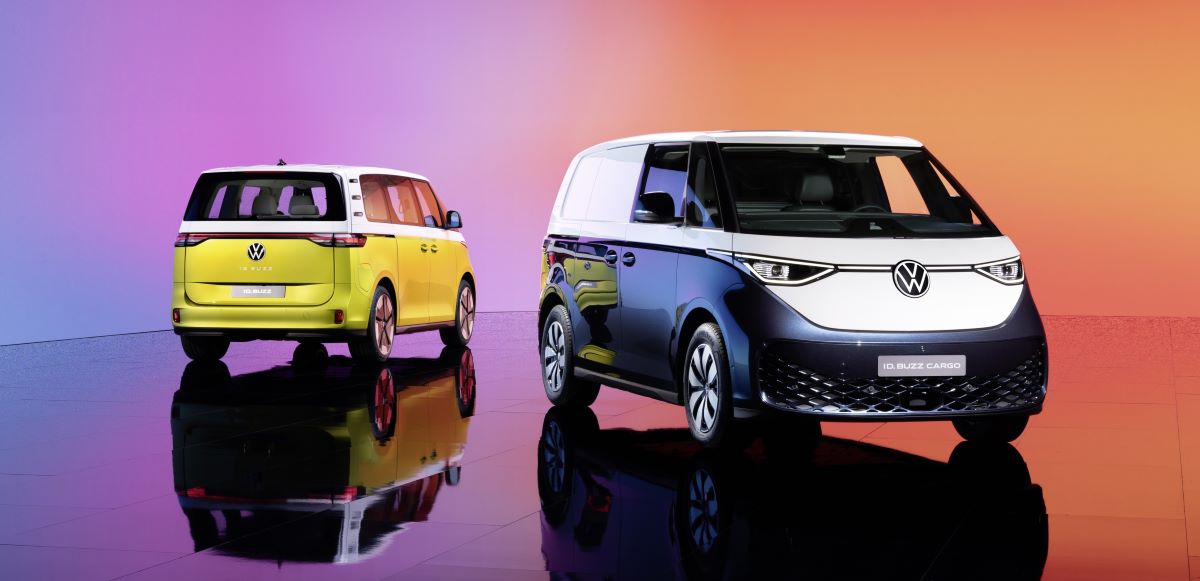VOLKSWAGEN Passenger Cars and Commercial Vehicles have given the new ID. Buzz and ID. Buzz Cargo their world premiere in Hamburg.
With Europe’s first all-electric bus and transporter range, VW is providing yet another solution to sustainable and CO2-free mobility. The ID. Buzz comes with the latest ID. software and sets new standards in its segment with the latest systems and functions for safety, comfort and charging.
Carsten Intra, Chairman of the Board of Management of the Volkswagen Commercial Vehicles Brand, said: “Both versions of the ID. Buzz are pioneering in terms of their sustainability: their manufacture and shipping has a carbon-neutral footprint. We are also using recycled synthetic materials and the interior is completely free of any real leather.
“The ID. Buzz will also be used for future autonomous mobility concepts such as ridepooling – an e-shuttle service of Group subsidiary MOIA that can be booked via an app. The electric Bulli is thus also a part of the future of inner-city transport.”
As is the case for all the models in Volkswagen Passenger Car’s ID. family, the ID. Buzz, which is built by Volkswagen Commercial Vehicles in Hannover, is also based in engineering terms on the Group’s Modular Electric Drive Kit (MEB).
The world’s first scalable mass production platform for all-electric cars provides the cross-brand basis for all sorts of different models and segments. Its architecture allows for an evolutionary further development of software and technology, which not only benefits new models such as the ID. Buzz, but also models that have already been delivered, by means of over-the-air updates.
The ID. Buzz and ID. Buzz Cargo are launching across Europe with a 77 kWh battery (gross energy content: 82 kWh). It provides current to a 150 kW electric motor, which – as the flat engine once did in the T1 – drives the rear axle. The position of the battery, integrated deep down in the sandwich floor, and the lightweight electric drive system result in a good distribution of weight and a low vehicle centre of gravity.
The lithium ion battery can be charged from wall boxes or public charging stations using 11 kW alternating current (AC). Via a CCS plug connector at a DC rapid-charging station (direct current) the charging power increases to as much as 170 kW.
When charged in this way, the battery charge level rises from 5 to 80% in about 30 minutes. Using the latest ID. software, the model line will also offer the ‘Plug & Charge’ function in the future. Via this function, the ID. Buzz authenticates itself at compatible DC rapid-charging stations via the charging connector using the ISO 15118 standard. It also exchanges all necessary data with the charging station in this way – an added convenience. Bidirectional charging enables the ID. Buzz to feed unneeded energy from the battery into the customer’s home network (Vehicle-to-Home). The power transfer and communication take place via a special DC bi-directional wall box.
One feature of the ID. Buzz and ID. Buzz Cargo is the long wheelbase of 2,988 mm, roughly the same as that of the current T6.1. The length of both versions is 4,712 mm. By virtue of what, in relation to the overall length, is a very long wheelbase, optimal use is made of the vehicle footprint. Including roof aerial, the two versions of ID. Buzz measure, dependent on specification, 1,937 mm or 1,938 mm in height. At 1,985 mm, the new model is 81 mm wider than a T6.1. The turning circle of 11.1 metres, meanwhile, is unusually small.
The ID. Buzz and ID. Buzz Cargo will go onto the market in the first few European countries this autumn. Advance sales are due to start in May. With the ID. Buzz, Volkswagen of America will also be initiating the comeback of the so-called microbus in the US and Canada.







Leave A Comment